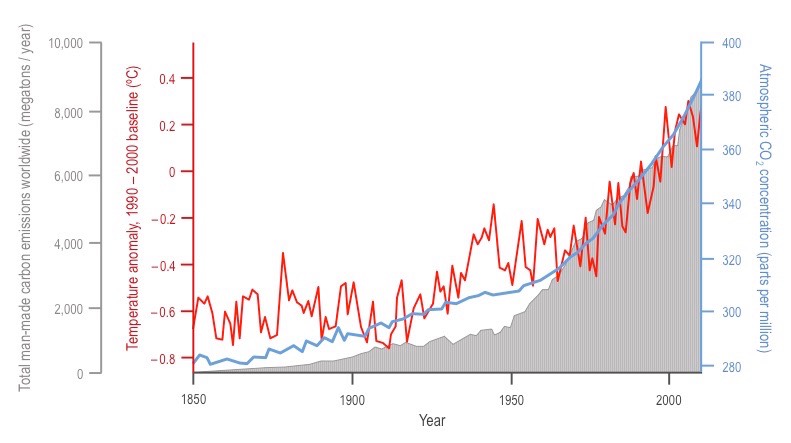![]()
Understanding:
• Global temperatures and climate patterns are influenced by concentration of greenhouse gases
Greenhouse gases play a pivotal role in determining global temperatures and climate patterns due to their capacity to retain heat
- As these gases trap heat, increases in greenhouse gas concentrations should correlate with an increase in global temperature
- Long term weather patterns (climate) may also be influenced by greenhouse gas concentrations
Scientists predict that increases in greenhouse gas concentrations will lead to an enhanced greenhouse effect, resulting in:
- More frequent extreme weather conditions (e.g. heat waves, cyclones, more powerful tropical storms, etc.)
- Some areas to become more drought affected, while other areas become more prone to periods of heavy rainfall
- Changes to circulating ocean currents – which may cause longer El Nino (warming) and La Nina (cooling) events
![]()
Application:
• Correlations between global temperatures and carbon dioxide concentrations on Earth
The link between global temperatures and carbon dioxide concentrations was established by analysing data over a long time period
- Ice cores taken from the Vostok station in Antarctica provide evidence of the environmental conditions at the time of freezing
- The Vostok ice core is one of the longest drilled, reaching back 420,000 years and covering the past four glacial cycles
- By analysing the gas bubbles trapped in ice, historical CO2 levels and air temperatures (via oxygen isotopes) can be deduced
Data collected from the Vostok ice core demonstrates that:
- There is a strong positive correlation between carbon dioxide concentrations and temperature (↑ CO2 levels ∝ ↑ temperature)
- There have been fluctuating cycles of CO2 concentrations which appear to correlate with global warm ages and ice ages
- Current concentrations of CO2 are higher than at any time recorded in the last 400,000 years
Vostok Ice Core Data – Temperature versus Carbon Dioxide Concentration

![]()
Understanding:
• There is a correlation between rising atmospheric concentrations of carbon dioxide since the start of the
industrial revolution 200 years ago and average global temperatures
The industrial revolution introduced new manufacturing processes which significantly increased mankind’s use of fossil fuels
- The burning of fossil fuels releases carbon dioxide as a by-product, leading to a steady increase in its atmospheric concentration
When fuel emissions, atmospheric CO2 concentrations and global temperatures are compared, the following trends are revealed:
- There is a strong positive correlation between increasing fossil fuel emissions and rising atmospheric concentrations of CO2
- Atmospheric CO2 concentrations have increased ~38% since pre-industrial times (1800: ~ 280 ppm ; 2010: ~ 380 ppm)
- About 40% of CO2 emissions have remained in the atmosphere, the rest has been absorbed by carbon sinks (mainly oceans)
- This increase in atmospheric carbon dioxide concentration correlates with an increase in average global temperature
- While correlation does not equal causation, there is mounting evidence to suggest that CO2 emissions are linked to global temperature changes (although other factors likely also contribute)
Carbon Dioxide Emissions, Atmospheric Concentrations and Global Average Temperatures

